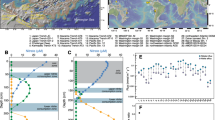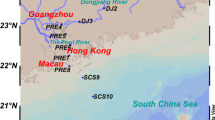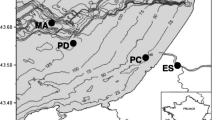Abstract
To extend the knowledge of anaerobic ammonium oxidation (anammox) habitats, bacterial communities were examined in two hypersaline sulphidic basins in Eastern Mediterranean Sea. The 2 m thick seawater–brine haloclines of the deep anoxic hypersaline basins Bannock and L’Atalante were sampled in intervals of 10 cm with increasing salinity. 15N isotope pairing incubation experiments showed the production of 29N2 and 30N2 gases in the chemoclines, ranging from 6.0 to 9.2 % salinity of the L’Atalante basin. Potential anammox rates ranged from 2.52 to 49.65 nmol N2 L−1 day−1 while denitrification was a major N2 production pathway, accounting for more than 85.5 % of total N2 production. Anammox-related 16S rRNA genes were detected along the L’Atalante and Bannock haloclines up to 24 % salinity, and the amplification of the hydrazine synthase genes (hzsA) further confirmed the presence of anammox bacteria in Bannock. Fluorescence in situ hybridisation and sequence analysis of 16S rRNA genes identified representatives of the marine anammox genus ‘Candidatus Scalindua’ and putatively new operational taxonomic units closely affiliated to sequences retrieved in marine environments that have documented anammox activity. ‘Scalindua brodae’ like sequences constituted up to 84.4 % of the sequences retrieved from Bannock. The anammox community in L’Atalante was different than in Bannock and was stratified according to salinity increase. This study putatively extends anammox bacterial habitats to extremely saline sulphidic ecosystems.





Similar content being viewed by others
References
Altschul SF, Madden TL, Schaffer AA, Zhang J, Zhang Z, Miller W, Lipman DJ (1997) Gapped BLAST and PSI-BLAST: a new generation of protein database search programs. Nucleic Acids Res 25:3389–3402
Borin S, Brusetti L, Mapelli F, D’Auria G, Brusa T, Marzorati M et al (2009) Sulfur cycling and methanogenesis primarily drive microbial colonization of the highly sulfidic Urania deep hypersaline basin. Proc Natl Acad Sci USA 106:9151–9156
Brandes JA, Devol AH, Deutsch C (2007) New developments in the marine nitrogen cycle. Chem Rev 107:577–589
Byrne N, Strous M, Crépeau V, Kartal B, Birrien JJ, Schmid M, Lesongeur F, Schouten S, Jaeschke A, Jetten M, Prieur D, Godfroy A (2009) Presence and activity of anaerobic ammonium-oxidizing bacteria at deep sea hydrothermal vents. ISME J 3:117–123
Canfield DE, Stewart FJ, Thamdrup B, De Brabandere L, Dalsgaard T, Delong EF, Revsbech NP, Ulloa O (2010) A cryptic sulfur cycle in oxygen-minimum-zone waters off the Chilean Coast. Science 330:1375–1378
Chen Y, Joly HA, Belzile N (1997) Determination of elemental sulphur in environmental samples by gas chromatography–mass spectrometry. Chem Geol 137:195–200
CIESM (2008) The Messinian Salinity Crisis from mega-deposits to microbiology—a consensus report. No. 33. CIESM Workshop Monographs. In: Briand F (ed) Commission Internationale pour l’Exploration de la Mer Mediterranee, Monaco, pp 1–168
Daffonchio D, Borin S, Brusa T, Brusetti L, Van der Wielen PWJJ, Bolhuis H et al (2006) Stratified prokaryote network in the oxic–anoxic transition of a deep sea halocline. Nature 440:203–207
Dale OR, Tobias CR, Song B (2009) Biogeographical distribution of diverse anaerobic ammonium oxidizing (anammox) bacteria in Cape Fear River Estuary. Environ Microbiol 11:1194–1207
Dalsgaard T, Canfield DE, Petersen J, Thamdrup B, Acuna-Gonzalez J (2003) N2 production by the anammox reaction in the anoxic water colun of Gulfo Dulce, Costa Rica. Nature 422:606–608
Dang HY, Chen RP, Wang L, Guo LZ, Chen PP, Tang ZW, Tian F, Li SZ, Klotz MG (2010) Environmental factors shape sediment anammox bacterial communities in hypernutrified Jiaozhou Bay, China. Appl Environ Microbiol 76:7036–7047
De Lange GJ, Catalano G, Klinkhammer GP, Luther GW III (1990a) The interface between oxic seawater and the anoxic Bannock Brine; its sharpness and the consequneces for the redox-related cycling of Mn and Ba. Mar Chem 31:205–217
De Lange GJ, Middelburg JJ, Van Der Weijden CH, Catalano G, Luther GW III, Hydes DJ, Woittiez JRW, Klinkhammer GP (1990b) Composition of anoxic hypersaline brines in the Tyro and Bannock Basins, eastern Mediterranean. Mar Chem 31:63–88
Dong LF, Smith CJ, Papaspyrou S, Stott A, Osborn MA, Nedwell DB (2009) Changes in benthic denitrification, nitrate ammonification, and anammox process rates and nitrate and nitrite reductase gene abundances along an estuarine nutrient gradient (the Colne estuary, United Kingdom). Appl Environ Microbiol 75:3171–3179
Hamersley RM, Lavik G, Woebken D, Rattray JE, Lam P, Hopmans EC, Sinninghe Damsté JS, Krüger S, Graco M, Gutiérrez D, Kuypers MMM (2007) Anaerobic ammonium oxidation in the Peruvian oxygen minimum zone. Limnol Oceanogr 52:923–933
Hamersley MR, Woebken D, Boehrer B, Schultze M, Lavik G, Kuypers MMM (2009) Water column anammox and denitrification in a temperate permanently stratified lake (Lake Rassnitzer, Germany). Sys Appl Microbiol 32:571–582
Hannig M, Lavik G, Kuypers MMM, Woebken D, Martens-Habena W, Jügens K (2007) Shift from denitrification to anammox after inflow events in the central Baltic Sea. Limnol Oceanogr 52:1336–1345
Harhangi HR, Le Roy M, van Alen T, Hu B-I, Groen J, Kartal B, Tringe SG, Quan Z-X, Jetten MSM, Op den Camp HJM (2012) Hydrazine synthase, a unique phylomarker with which to study the presence and biodiversity of anammox bacteria. Appl Environ Microbiol 78:752–758
Hietanen S, Jäntti H, Buizert C, Jürgens K, Labrenz M, Voss M, Kuparinen J (2012) Hypoxia and nitrogen processing in the Baltic Sea water column. Limnol Oceanogr 57:325–337
Hopmans EC, Kienhuis MVM, Rattray JE, Jaeschke A, Schouten S, Sinninghe Damsté JS (2006) Improved analysis of ladderane lipids in biomass and sediments using high-performance liquid chromatography/atmospheric pressure chemical ionization tandem mass spectrometry. Rapid Commun Mass Spectrom 20:2099–2103
Jaeschke A, Op den Camp HJM, Harhangi H, Klimiuk A, Hopmans EC, Jetten MSM, Schouten S, Sinninghe Damsté JS (2009) 16S rRNA gene and lipid biomarker evidence for anaerobic ammonium-oxidizing bacteria (anammox) in California and Nevada hot springs. FEMS Ecol 67:343–350
Jensen MM, Kuypers MMM, Lavik G, Thamdrup B (2008) Rates and regulation of anaerobic ammonium oxidation and denitrification in the Black Sea. Limnol Oceanogr 53:23–36
Jensen MM, Lam P, Revsbech NP, Nagel B, Gaye B (2011) Intensive nitrogen loss over the Omani Shelf due to anammox coupled with dissimilatory nitrite reduction to ammonium. ISME J 5:1–11
Jetten MSM, Schmid M, Van de Pas-Schoonen KT, Damste JSS, Strous M (2005) Anammox organisms: enrichment, cultivation and environmental analysis. Methods Enzymol 397:34–57
Jetten MSM, van Niftrik L, Strous M, Kartal B, Keltjens JT, Op den Camp HJM (2009) Biochemistry and molecular biology of anammox bacteria. Crit Rev Biochem Mol Biol 44:65–84
Koop-Jackobsen K, Giblin AE (2009) Anammox in tidal marsh sediments: the role of salinity, nitrogen loading, and marsh vegetation. Estuaries Coasts 32:238–245
Kuypers MMM, Sliekers AO, Lavik G, Schmid M, Jørgensen BB, Kuenen JG, Sinninghe Damste JS, Strous M, Jetten MSM (2003) Anaerobic ammonium oxidation by anammox bacteria in the Black Sea. Nature 422:608–611
Kuypers MMM, Lavik G, Woebken D, Schmid M, Fuchs BM, Amann R et al (2005) Massive nitrogen loss from the Benguela upwelling system through anaerobic ammonium oxidation. Proc Natl Acad Sci USA 102:6478–6483
Lam P, Lavik G, Jensen MM, van de Vossenberg J, Schmid M, Woebken D, Gutiérrez D, Amann R, Jetten MSM, Kuypers MMM (2009) Revising the nitrogen cycle in the Peruvian oxygen minimum zone. Proc Natl Acad Sci USA 106:4752–4757
Lozupone C, Knight R (2005) UniFrac: a new phylogenetic method for comparing microbial communities. Appl Environ Microbiol 71:8228–8235
Luther GW III, Catalano G, De Lange GJ, Woittiez JRW (1990) Reduced sulphur in the hypersaline anoxic basins of the Mediterranean Sea. Mar Chem 31:137–152
Rattray J (2008) Ladderane lipids in annamox bacteria: occurrence, biosynthesis and application as environmental markers. PhD thesis, University of Utrecht
Schloss PD, Westcott SL, Ryabin T, Hall JR, Hartmann M, Hollister EB et al (2009) Introducing mothur: open-source, platform-independent, community-supported software for describing and comparing microbial communities. Appl Environ Microbiol 75:7537–7541
Schmid M, Walsh K, Webb R, Rijpstra WI, van de Pas-Schoonen K, Verbruggen MJ et al (2003) Candidatus “Scalindua brodae”, sp. nov., Candidatus “Scalindua wagneri”, sp. nov., two new species of anaerobic ammonium oxidizing bacteria. Syst Appl Microbiol 26:529–538
Schmid M, Maas B, Dapena A, Van de Pas-Schoonen K, Van de Vossemberg J, Kartal B et al (2005) Biomarkers for in situ detection of anaerobic ammonium-oxidizing (anammox) bacteria. Appl Environ Microbiol 71:1677–1684
Schmid MC, Risgaard-Petersen N, van de Vossenberg J, Kuypers MMM, Lavik G, Petersen J et al (2007) Anaerobic ammonium-oxidizing bacteria in marine environments: widespread occurrence but low diversity. Environ Microbiol 9:1476–1484
Schmidt I, Sliekers O, Schmid M, Cirpus I, Strous M, Bock E, Kuenen JG, Jetten MSM (2001) Aerobic and anaerobic ammonia oxidizing bacteria—competitors or natural partners? FEMS Microbiol Ecol 39:175–181
Singleton DR, Furlong MA, Rathbun SL, Whitman WB (2001) Quantitative comparisons of 16S rRNA gene sequence libraries from environmental samples. Appl Environ Microbiol 67:4374–4376
Tamura K, Peterson D, Peterson N, Stecher G, Nei M, Kumar S (2011) MEGA5: molecular evolutionary genetics analysis using maximum likelihood, evolutionary distance, and maximum parsimony methods. Mol Biol Evol 28:2731–2739
Thamdrup B, Dalsgaard T (2002) Production of N2 through anaerobic ammonium oxidation coupled to nitrate reduction in marine sediments. Appl Environ Microbiol 68:1312–1318
Thamdrup B, Dalsgaard T, Jensen MM, Ulloa O, Farias L, Escribano R (2006) Anaerobic ammonium oxidation in the oxygen-deficient waters off northern Chile. Limnol Oceanogr 51:2145–2156
Thompson JD, Gibson TJ, Plewniak F, Jeanmougin F, Higgins DG (1997) The ClustalX windows interface: flexible strategies for multiple sequence alignment aided by quality analysis tools. Nucleic Acid Res 24:4876–4882
van de Vossenberg J, Rattray JE, Geerts W, Kartal B, van Niftrik L, van Donselaar EG et al (2008) Enrichment and characterization of marine anammox bacteria associated with global nitrogen gas production. Environ Microbiol 10(11):3120–3129
Van der Wielen PWJJ, Bolhuis H, Borin S, Daffonchio D, Corselli C, Giuliano L et al (2005) The enigma of prokaryotic life in deep hypersaline anoxic basins. Science 307:121–123
Wakeham SG, Amann R, Freeman KH, Hopmans EC, Jørgensen BB, Putnam IF et al (2007) Microbial ecology of the stratified water column of the Black Sea as revealed by a comprehensive biomarker study. Org Geochem 38:2070–2097
Ward BB, Tuit CB, Jayakumar A, Rich JJ, Moffett J, Vaqvi SWA (2008) Organic carbon, and not copper, controls denitrification in oxygen minimum zones of the ocean. Deep-Sea Res. I 55:1672–1683
Woebken D, Lam P, Kuypers MMM, Naqvi SWA, Kartal B, Strous M et al (2008) A microdiversity study of anammox bacteria reveals a novel Candidatus Scalindua phylotype in marine oxygen minimum zones. Environ Microbiol 10:3106–3119
Yakimov MM, La Cono V, Denaro R, D’Auria G, Decembrini F, Timmis KN et al (2007) Primary producing prokaryotic communities of brine, interface and seawater above the halocline of deep anoxic lake L’Atalante, Eastern Mediterranean Sea. ISME J 0:1–13
Zhang Y, Ruan XH, Op den Camp HJMO et al (2007) Diversity and abundance of aerobic and anaerobic ammonium-oxidizing bacteria in freshwater sediments of the Xinyi River (China). Environ Microbiol 9:2375–2382
Zhu GB, Wang SY, Wang Y, Wang CX, Risgaard-Petersen N, Jetten MSM, Yin CQ (2011) Anaerobic ammonia oxidation in a fertilized paddy soil. ISME J 5:1905–1912
Acknowledgments
We thank the masters and crews of the R/V Urania, R/V Pelagia, R/V Universitatis for excellent technical assistance. K. Bakker is acknowledged for chemical analyses on board and at NIOZ (Texel, The Netherlands). Financial support was obtained from NWO projects MOCCHA and MIDDLE. Song and Tobias were supported by NSF (Biological Oceanography, grant OCE-0851435), Jetten by ERC (grant ERC232937), Rolli and Mapelli were supported by Università degli Studi di Milano, European Social Found (FSE) and Regione Lombardia (contract “Dote Ricerca”). This work has been conducted in the frame of the European Community FP7-KBBE-2010-4 project ULIXES, grant agreement N. 266473.
Author information
Authors and Affiliations
Corresponding author
Additional information
Communicated by A. Oren.
Rights and permissions
About this article
Cite this article
Borin, S., Mapelli, F., Rolli, E. et al. Anammox bacterial populations in deep marine hypersaline gradient systems. Extremophiles 17, 289–299 (2013). https://doi.org/10.1007/s00792-013-0516-x
Received:
Accepted:
Published:
Issue Date:
DOI: https://doi.org/10.1007/s00792-013-0516-x




